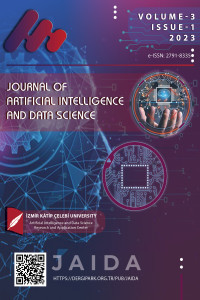Öz
Kaynakça
- [1] Cui, C., Hu, M., Weir, J. D., & Wu, T. (2016). A recommendation system for meta-modeling: A meta-learning based approach. Expert Systems with Applications, 46, 33-44.
- [2] Mittra, R., Chan, C. H., & Cwik, T. (1988). Techniques for analyzing frequency selective surfaces-a review. Proceedings of the IEEE, 76(12), 1593-1615.
- [3] Mahouti, P., Belen, A., Tari, O., Belen, M. A., Karahan, S., & Koziel, S. (2023). Data-Driven Surrogate-Assisted Optimization of Metamaterial-Based Filtenna Using Deep Learning. Electronics, 12(7), 1584.
- [4] Koziel, S., Belen, M. A., Çalişkan, A., & Mahouti, P. (2023). Rapid Design of 3D Reflectarray Antennas by Inverse Surrogate Modeling and Regularization. IEEE Access, 11, 24175-24184.
- [5] Mahouti, P. (2019). Design optimization of a pattern reconfigurable microstrip antenna using differential evolution and 3D EM simulation‐based neural network model. International Journal of RF and Microwave Computer‐Aided Engineering, 29(8), e21796.
- [6] Smola, A. J., & Schölkopf, B. (2004). A tutorial on support vector regression. Statistics and computing, 14, 199-222.
- [7] Persson, C., Bacher, P., Shiga, T., & Madsen, H. (2017). Multi-site solar power forecasting using gradient boosted regression trees. Solar Energy, 150, 423-436.
- [8] Calik, N., Belen, M. A., & Mahouti, P. (2020). Deep learning base modified MLP model for precise scattering parameter prediction of capacitive feed antenna. International journal of numerical modelling: electronic networks, devices and fields, 33(2), e2682.
- [9] Güneş, F., Demirel, S., & Mahouti, P. (2014). Design of a front–end amplifier for the maximum power delivery and required noise by HBMO with support vector microstrip model. Radioengineering, 23(1), 134-143.
- [10] Haddad, O. B., Afshar, A., & Mariño, M. A. (2006). Honey-bees mating optimization (HBMO) algorithm: a new heuristic approach for water resources optimization. water resources management, 20, 661-680.
Öz
Efficient and accurate modelling approaches have become necessary in computational science and engineering due to the rising complexity and high dimensionality of physical and engineered systems. The utilisation of data-driven surrogate modelling has surfaced as a potent methodology to overcome the disparity between computationally expensive simulations and prompt, dependable predictions. The current study offers a thorough examination of data-driven surrogate modelling methods as they pertain to the optimisation and design of microstrip frequency selective surfaces (FSSs) within microwave systems. In this discourse, we delve into the rudiments of surrogate modelling, diverse categories of surrogate models, and their respective merits and demerits in the realm of FSS modelling. The utilisation of widely used Artificial Intelligence algorithms is implemented for the purpose of data-driven surrogate modelling, and their efficacy is evaluated through the Relative Mean Error metric. The research findings indicate that the M2LP surrogate model exhibits optimal performance in the specific scenario under investigation. Furthermore, the Honey Bee Mating Optimisation algorithm is utilised to optimise the design of FSS. The results of our study demonstrate that data-driven surrogate modelling is an efficient and effective method for designing and optimising microstrip frequency selective surfaces (FSSs). Specifically, our approach yielded a gain improvement of nearly 3 dB within the chosen frequency band. The forthcoming research endeavours to investigate the optimisation of more intricate FSS designs for analogous applications that encompass broader operation bands.
Anahtar Kelimeler
Kaynakça
- [1] Cui, C., Hu, M., Weir, J. D., & Wu, T. (2016). A recommendation system for meta-modeling: A meta-learning based approach. Expert Systems with Applications, 46, 33-44.
- [2] Mittra, R., Chan, C. H., & Cwik, T. (1988). Techniques for analyzing frequency selective surfaces-a review. Proceedings of the IEEE, 76(12), 1593-1615.
- [3] Mahouti, P., Belen, A., Tari, O., Belen, M. A., Karahan, S., & Koziel, S. (2023). Data-Driven Surrogate-Assisted Optimization of Metamaterial-Based Filtenna Using Deep Learning. Electronics, 12(7), 1584.
- [4] Koziel, S., Belen, M. A., Çalişkan, A., & Mahouti, P. (2023). Rapid Design of 3D Reflectarray Antennas by Inverse Surrogate Modeling and Regularization. IEEE Access, 11, 24175-24184.
- [5] Mahouti, P. (2019). Design optimization of a pattern reconfigurable microstrip antenna using differential evolution and 3D EM simulation‐based neural network model. International Journal of RF and Microwave Computer‐Aided Engineering, 29(8), e21796.
- [6] Smola, A. J., & Schölkopf, B. (2004). A tutorial on support vector regression. Statistics and computing, 14, 199-222.
- [7] Persson, C., Bacher, P., Shiga, T., & Madsen, H. (2017). Multi-site solar power forecasting using gradient boosted regression trees. Solar Energy, 150, 423-436.
- [8] Calik, N., Belen, M. A., & Mahouti, P. (2020). Deep learning base modified MLP model for precise scattering parameter prediction of capacitive feed antenna. International journal of numerical modelling: electronic networks, devices and fields, 33(2), e2682.
- [9] Güneş, F., Demirel, S., & Mahouti, P. (2014). Design of a front–end amplifier for the maximum power delivery and required noise by HBMO with support vector microstrip model. Radioengineering, 23(1), 134-143.
- [10] Haddad, O. B., Afshar, A., & Mariño, M. A. (2006). Honey-bees mating optimization (HBMO) algorithm: a new heuristic approach for water resources optimization. water resources management, 20, 661-680.
Ayrıntılar
| Birincil Dil | İngilizce |
|---|---|
| Konular | Yapay Zeka |
| Bölüm | Research Articles |
| Yazarlar | |
| Yayımlanma Tarihi | 30 Haziran 2023 |
| Gönderilme Tarihi | 1 Mayıs 2023 |
| Yayımlandığı Sayı | Yıl 2023 Cilt: 3 Sayı: 1 |
All articles published by JAIDA are licensed under a Creative Commons Attribution 4.0 International License.



